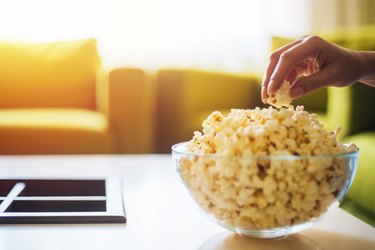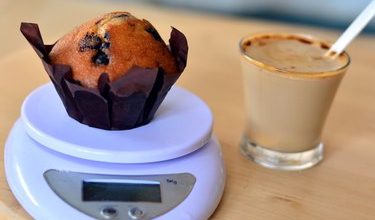Trying to Lose Weight? Here Are 6 Carbs to Enjoy and 3 to Avoid

agrobacter/iStock/GettyImages
Avoiding bananas, beans and bread because of the keto diet or any other weight-loss fad you’re following? If you’re limiting carbs in this way, you might be taking the wrong dietary approach.
The trouble with “cutting carbs” to lose weight is that we’re lumping all sources of carbohydrates into one group.
Video of the Day
Video of the Day
Beans and gummy bears are both carbs but are far from the same when it comes to their nutritional value. Same goes for a candy bar and a banana: Both are a source of carbohydrates but they offer up very different macro and micronutrients.
As it is, whole grains and fruit account for less than 10 percent of our diet, per a September 2019 paper in the Journal of the American Medical Association (JAMA).
The question is, what’s happening in the other 90 percent of our diet? A big chunk — about 42 percent — of the portion of our diet that’s not devoted to whole grains and fruits is made up of low-quality carbs, such as sugary cereal and white bread. These are the sources of carbohydrates that we need to limit in our diets when it comes to our weight and overall health, not fruit and whole grains.
Here, good-for-you carbs that’ll fill you up and deliver nutrients, along with carbs to avoid.
6 Carbs to Add When You’re Trying to Lose Weight
1. Potatoes
paulrichstudio/iStock/GettyImages
This goes for all potatoes — red skinned, purple, sweet and the regular ol’ white potato. Yes, that one too.
When it comes to nutritious potato options, sweet potatoes often overshadow white spuds because of their rich orange color, which is an indication of their beta-carotene content. White potatoes are well, white, which we often associate with meaning a lack of nutrients, in addition to our antiquated “must avoid all white carbs” line of thinking.
But all potatoes are a source of good-for-you carbohydrates.
For starters, they’re nutrient-dense. A medium potato (with skin) has just 118 calories and one gram of sugar while providing 3 grams of protein, 27 grams of carbohydrates, 2.5 grams of fiber, 20 percent of the daily value (DV) of vitamin C, 24 percent DV of vitamin B6 and 11 percent DV of folate, according to the United States Department of Agriculture (USDA).
When it comes to weight loss, potatoes are unique from many other foods in that they have resistant starch, per a February 2020 narrative review in the Journal of the Academy of Nutrition and Dietetics. This specific type of fiber may decrease the number of calories we process and increase satiety, along with other health benefits. One trick is cooking and then cooling a potato, like with a potato salad. This increases the amount of resistant starch.
2. Oatmeal
Oatmeal is one of the first things to go when you start following a low-carb/keto diet and this isn’t just unnecessary, it can be counterproductive if you’re trying to lose weight.
Like potatoes, oats also have a unique compound called beta-glucan. A growing body of research indicates that beta-glucan suppresses our appetite and increases our satiety, as reported in an August 2018 paper in Appetite.
Researchers of the study compared the effects of breakfast with beta-glucan versus one without. The group filling up on beta-glucan in the a.m. felt fuller afterwards, compared to the other non-beta-glucan group.
3. Popcorn
This one always seems to surprise. Yes, popcorn is a nutritious source of carbs — it’s even a whole grain.
But choose wisely. A serving (about 3 cups) of air-popped popcorn has just 92 calories and 1 gram of fat while providing 19 grams of carbs and 4 grams of fiber, per the USDA. But that same size serving of movie theater popcorn has 276 calories, 25 grams of fat, 15 grams of saturated fat, 13 grams of carb and 2 grams of fiber, according to the USDA. Keep in mind, a small order of movie popcorn has 735 calories (!).
This makes (air-popped) popcorn a healthy and weight-loss-friendly snack. Turns out, the average adult eats about 420 to 585 calories of snacks per day, according to the USDA. When snacking accounts for nearly 30 percent of your total intake, it pays to make it count by noshing on healthier options.
4. Whole-Grain Bread
Bread has been demonized by low-carb enthusiasts but it’s important to keep in mind that all bread is not created equal — there’s bread that is whole-grain and then there’s refined.
Whole grain means the entire grain is intact, ensuring you’re getting all of the fiber and nutrients. A refined grain has been stripped of at least one of its three parts, usually the bran and germ, which removes some of the fiber, vitamins, minerals and healthy fats.
When you lump all grains together while cutting out carbs, you’re doing yourself a disservice, especially when it comes to weight loss. Whole grains, which definitely include whole-grain bread, may give a modest boost to your metabolism, per a March 2017 study in the American Journal of Clinical Nutrition.
5. Raspberries
Michelle Arnold / EyeEm/EyeEm/GettyImages
Raspberries are loaded with fiber, which is a key nutrient when it comes to losing weight. In fact, they’re one of the fruits highest in fiber with 8 grams per cup, according to the USDA. The only fruits with more are guava, avocado and passion fruit. Just think, eating one cup of raspberries provides about one-third of your entire fiber intake for the day, for most adults.
So often when we’re trying to lose weight we focus on cutting out calories or cutting out carbs but an October 2019 study in the Journal of Nutrition found this is likely the wrong approach.
Researchers put subjects on a number of calorie-restricted diets varying in macronutrients i.e., low-fat, high protein, low-carb, high-carb, etc. After six months, they concluded that fiber intake, regardless of the macronutrient and calorie intake, was the biggest factor when it came to promoting weight loss and adhering to a calorie-restricted diet.
6. Legumes
We need to be eating more legumes, plain and simple.
The 2015-2020 Dietary Guidelines for Americans compared the recommended intake to what we’re currently eating as a nation and the gap is wide. We only need to eat about 1 to 2 cups per week (depending on your calorie intake), which is nominal, although most dietitians would likely argue that you could benefit from more.
When it comes to losing weight, it’s good to add legumes to your plate. Legume eaters (those who eat a three-fourths cup per day) lost more weight than those who didn’t eat legumes, regardless of whether the diets were geared towards weight loss, per a March 2016 analysis in the American Journal of Clinical Nutrition that reviewed the data from about 20 studies.
3 Carbs to Limit if You’re Trying to Lose Weight
1. White Bread
Bread on its own doesn’t cause weight gain. It’s eating an excess of calories that leads to gaining pounds. But certain foods fill you up and satisfy you more effectively than others. Refined grains, like white bread, are not one of these foods.
While clinical trials have been inconclusive in determining the benefits of refined and whole grains when it comes to weight loss, studies that look at diets longer term, like five years, have found a correlation between greater whole grain consumption and a reduced BMI, as outlined in a June 2019 study in Nutrients.
2. Sugary Breakfast Cereals
serezniy/iStock/GettyImages
Sugary breakfast cereals aren’t doing you any favors. Sure, saving the colorful sweet marshmallows to slurp up with your milk is tasty and all, but you’ll likely feel hungry soon after.
We have a sugar problem in the U.S. We currently eat two to three times as much as we should, which could be trouble for our waistlines, per Johns Hopkins Medicine. And while foods like doughnuts, chocolate and soda are obvious sources of added sugars, there are others, like breakfast cereals that may go undetected. Look for cereals with less than 10 grams of sugar per serving.
3. Refined Pasta
No one food will make you gain weight. It’s your diet as a whole that matters most. But if semolina (refined) pasta is part of your regular diet, leveling up by switching to a more nutrient-rich version will help you in the long run.
Because this pasta is made from refined grains, it’s processed more quickly by your body, which raises blood sugars more quickly and leaves you feeling hungry sooner.
Fortunately, while our options in the pasta aisle used to be limited, these days, we can choose from noodles made out of red lentils, chickpeas, black beans and even konjac (a starchy plant).
These whole grains and legumes are higher in fiber, which slows digestion and leaves you feeling fuller longer, and legume-based pasta specifically has more protein, the most satiating macronutrient, per a July 2016 paper in Annual Reviews.




